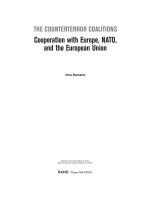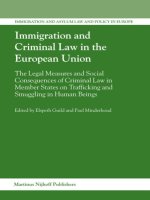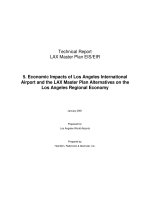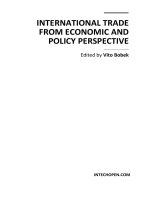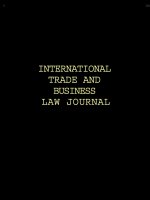- Trang chủ >>
- Cao đẳng - Đại học >>
- Luật
International Trade and Economic Law and the European Union
Bạn đang xem bản rút gọn của tài liệu. Xem và tải ngay bản đầy đủ của tài liệu tại đây (1.16 MB, 412 trang )
INTERNATIONAL TRADE AND ECONOMIC LAW
AND THE EUROPEAN UNION
International Trade and
Economic Law and
the European Union
SARA DILLON
PhD (Stanford), J.D. (Columbia),
Associate Professor of Law,
Suffolk University Law School, Boston, Mass
OXFORD – PORTLAND, OREGON
2002
Hart Publishing
Oxford and Portland, Oregon
Published in North America (US and Canada) by
Hart Publishing c/o
International Specialized Book Services
5804 NE Hassalo Street
Portland, Oregon
97213-3644
USA
Distributed in the Netherlands, Belgium and Luxembourg by
Intersentia, Churchillaan 108
B2900 Schoten
Antwerpen
Belgium
© Sara Dillon 2002
The author has asserted her right under the Copyright,
Designs and Patents Act 1988, to be identified as the author of this work
Hart Publishing is a specialist legal publisher based in Oxford, England.
To order further copies of this book or to request a list of other
publications please write to:
Hart Publishing, Salter’s Boatyard, Folly Bridge,
Abingdon Road, Oxford OX1 4LB
Telephone: +44 (0)1865 245533 or Fax: +44 (0)1865 794882
e-mail:
WEBSITE: http//www.hartpub.co.uk
British Library Cataloguing in Publication Data
Data Available
ISBN 1–84113–113–X (paperback)
Typeset by Hope Services (Abingdon) Ltd.
Printed and bound in Great Britain on acid-free paper by
Biddles Ltd, www.biddles.co.uk
Foreword
With the accession of China, and the successful launch at Doha of a new round
of international trade negotiations (however fraught with contradictions the
opening ministerial declaration), it would seem that the World Trade
Organisation (WTO) is here to stay. Whatever doubts there may have been after
the Seattle Ministerial debacle of late 1999 with respect to the long-term viability of WTO law have apparently been put to rest after the events of September
11, 2001. At moments of global crisis, economic integration re-emerges as a
symbol of stability. The more difficult question, however, is what form this economic integration should take.
With the anti-globalisation movement in a state of some confusion in the
wake of September’s events, the WTO’s Doha conference moved forward, and
an uneasy basis for future action agreed upon. It would be folly, however, to
imagine that the intellectual difficulties presented by WTO law—with its unsettling relationship to national regulatory goals—have also disappeared.
As trade negotiations proceed under the new round in the months to come,
there will be an urgent need for far greater numbers of people than heretofore
to involve themselves in shaping global trade law. The outcome of the new
round should be, and hopefully will be, the result of more complex intellectual
and political inputs than was the case with the Uruguay Round Agreements, the
substantive law of which came into force in 1995, generating controversy and
street conflict in the years that followed.
The Doha Ministerial Declaration reflects in places the variegated protests
that hounded trade meetings in the late 1990s wherever they occurred, prominently mentioning the special difficulties of developing countries, trade and environment concerns, and the matter of an improved “dialogue with the public”.1
There are indications of a general commitment to further liberalisation in the
areas of agriculture, investments, and trade in services; also to taking up the
issue of a “multilateral framework to enhance the contribution of competition
policy to international trade and development”. Commentators are already
making predictions as to where the concessions and climb-downs will come
from; will the EU hold firm on agriculture? Will the developing countries give in
on the introduction into WTO law of new subject areas?
There are also signs that the most high-profile of the contentious WTO issues
will be addressed in the spirit of preserving the WTO as a whole; notably, the
fact that a separate Declaration on the TRIPS Agreement and Public Health
calls for an interpretation of the Agreement on Trade-Related Aspects of
1
Ministerial Declaration, WT/MIN(01)/DEC/1, 20 November 2001.
vi Foreword
Intellectual Property (TRIPS) to allow for the granting of compulsory licenses
for patented drugs in the event of national public health emergencies.2 There is
little question but that many WTO insiders would like to move on from this persistent controversy, which has had the effect of characterising the entire WTO
as harsh and unfair in the public mind.
It is unclear at this juncture the degree to which the issues around which antiglobalisation protests have taken place over the last several years will be
reflected in the actual WTO negotiating agenda as it takes shape in the near
future. To the extent that the interests of developing countries (not to mention
disparate groups within those countries), environmental activists, labor advocates, and anti-debt campaigners pursue very different, and sometimes conflicting, agendas, the possibility of fundamental reform of the global trade regime is
correspondingly lessened.
This book suggests that the EU model of economic integration offers a far
more fruitful and complex human endeavour than what has been seen from the
WTO thus far. But as we enter the new negotiating round, it is important to consider that the ultimate shape of WTO law is still to be determined. What
GATT/WTO law has undertaken so far—including its purposes, methods and
achievements—is the principal subject of this book.
I would like to offer sincere thanks to Richard Hart of Hart Publishing, to
friends and colleagues at University College Dublin, Brooklyn Law School, and
Suffolk University Law School. Special mention and gratitude go to my research
assistant extraordinaire, Mr Marc Monte, 2001 graduate of Brooklyn Law
School; thanks also to Ms Anne Gates-Gurski of Suffolk University Law School.
2
WT/MIN(01)/DEC/2, 20 November 2001.
Contents
Table of Cases
xiii
PART I
GLOBAL CONTEXT
1 Introduction: The Problem of Europe in a Globalised World
“Trade Rights as European Rights”
Methodologies of Integration: The EC and the WTO
EU identity in the development of global governance
How this book should be read
Structure and purpose of the book
Focus on the disputes
2 Early GATT
7
10
14
19
21
22
25
Other GATT provisions of particular importance
GATT over time
The intervening decades
The earliest GATT disputes: nullification or impairment of GATT
“benefit”
Anti-legalism and the tumultuous 1960s
The age of the Tokyo Round: new areas of concern reflected in
stand-alone codes
GATT’s adolescence: the DISC case
Anticipating the Uruguay Round
The Dispute Settlement Understanding
Institutional basis: the WTO itself
New areas of GATT/WTO law: Trade post-1995
PART II
1
33
38
39
42
49
49
52
53
56
58
59
THE EFFECTS OF THE URUGUAY ROUND
3 Intellectual Property Rights and Trade: Creating the TRIPS
Agreement
Intellectual property and the old GATT
The coming of TRIPS
Indian Pharmaceuticals
63
64
67
71
viii Contents
Canadian generic drugs
Canadian term of patent protection
The US “Fairness in Music Licensing” Act
4 “Free Trade in Investments”
The FIRA case
International instruments to protect investments before the adoption of
the TRIMS Agreement
Bilateral Investment Treaties (BITs) and Bilateral Investment Protection
Agreements (BIPAs)
The OECD and investments
Multilateral liberalisation of investment regimes:
the TRIMs Agreement
Export Subsidies Law dovetails with TRIMs
Investing in Indonesia’s Automobile Industry
Claims of MFN violations
Claims of serious prejudice under the Subsidies Agreement
TRIPs arguments
The Canadian Automotive Industry
The Multilateral Agreement on Investments (MAI)
5 “Trade and the Environment”: International trade rules and
national regulation of the environment
Pre-Uruguay Round
Tuna-Dolphin
The Thai Cigarettes case
Trade and the environment, post-Uruguay Round
The Agreement on Technical Barriers to Trade (TBT Agreement)
The “Beef Hormones” dispute
The Sea Turtle case
United States—import prohibition of certain shrimp and
shrimp products
The Canadian Salmon case
The Asbestos case: how real is the change of emphasis?
The Appellate Body and the asbestos dispute
Conclusion
6 The trouble with Trade in Agriculture
Pre-Uruguay Round
Agriculture enters the global free trade system
Canada’s “export subsidies”
The Millennium Round on agriculture
Submissions of WTO members at the outset of the new round
79
82
84
93
94
96
97
99
101
103
106
111
111
113
114
116
119
122
122
126
128
130
131
141
148
153
157
166
173
175
177
179
182
188
189
Contents ix
7 Safeguards: Escape clauses and the power of self-protection
The Uruguay Round Agreement on safeguards: new rules for invoking
Article XIX
Disputes under the Safeguard Agreement
Korean Skimmed Milk Powder
The Appellate Body on Korean Dairy Safeguards
Argentine Footwear Safeguards
Argentine Footwear and the Appellate Body
US Safeguards on Wheat Gluten
The Appellate Body and causality
US measures on imports of lamb meat
Safeguards disputes seen in the aggregate
8 Liberalising the Textile trade: The only Uruguay Round
Agreement of clear benefit to the Developing World?
Structure and content of the agreement on textiles and clothing
Litigation under the ATC
The requirements of joining an Advanced customs union: India v. Turkey
197
200
203
203
208
210
213
213
220
224
228
229
231
234
240
9 The Power of the General Agreement on Trade in Services
(GATS)
251
The General Agreement on Trade in Services (GATS)
GATS at work: The Banana dispute
Outline of the 1993 European Banana Regime
The Banana panel on the substantive issues arising in the case
The Lomé waiver
Agriculture Agreement issues
Licensing procedures challenged under GATT
The GATS issues
The EC Banana Regime and the Appellate Body
Fuji-Kodak: A special role for the Services Agreement?
Canadian Automotive Industry case
GATS, the import duty exemption, and the Appellate Body
The future of GATS
252
257
259
262
263
264
264
265
267
269
272
275
279
10 National measures against dumping and subsidies
283
Anti-dumping actions: the last of the (somewhat) low-cost
protectionist devices?
283
Pre-1995 actions: Japan’s anti-dumping complaint
The development of European anti-dumping legislation
Community anti-dumping law and the problem of circumvention
285
287
288
x Contents
The Uruguay Round Agreement on the implementation of Article VI
(anti-dumping)
WTO anti-dumping disputes
Korea v. US: Anti-dumping duty on Dynamic Random Access Memory
Semiconductors (DRAMS)
Challenging US anti-dumping legislation
Future Development of WTO Anti-Dumping Law
The Scope of WTO Subsidies Law: recent disputes under the SCM
Agreement
National Tax Law as an export subsidy: the DISC case revisited
Subsidies to the Aircraft Industry
Disciplining Anti-Dumping, Anti-Subsidies and Subsidies
PART III
290
294
294
298
303
303
304
310
316
EXTERNAL TRADE RELATIONS OF
THE EUROPEAN UNION
11 European External Trade Relations: Uniformity Without
Building blocks of the Common Commercial Policy
Rules of origin
External charges equivalent to customs duties
Community competence to conclude and participate in International
Agreements
Exclusive competence in matters falling under the CCP: the nature of
exclusivity
Opinion 1/78 (The Natural Rubber Agreement)
External agreements on non-CCP subject matter: How does the
Community gain competence?
The ERTA case: parallelism and external competence
Inland Waterways opinion: a stronger parallelism
An expanding definition of the Common Commercial Policy
The new Commercial Policy instrument and the Trade Barriers
instrument
The original regulation
The Community’s monopoly to interpret GATT commitments
Trade safeguards for the EC Member States: a rare and narrow opt out
National freedom to restrict exports?
Two views of a segmented market
Opinion 1/94: A retreat from absolute uniformity?
12 The European Court of Justice meets GATT Law: The Power of
First Impressions
The Court and the GATT Agreement
The Court of Justice and other Free Trade Agreements
319
319
321
324
325
326
328
329
329
331
332
334
334
337
338
341
342
344
355
357
361
Contents xi
Limits to the similarity between concepts common to the EC Treaty
and Free Trade Agreements: Polydor
Kupferberg: Why so different from International Fruit?
Direct effect for Association Agreements: Sevince
When is GATT Law Community Law?
Continuing efforts to invoke GATT Law: Siot and SPI and SAMI
The growing GATT/WTO—EC Law struggle
High water mark of GATT Law in the Community legal order:
Fediol
When a Member State’s interests lie with GATT Law: Germany v.
Council
Portuguese Republic v. Council of the European Union
Index
362
363
365
367
368
370
372
375
378
387
Table of Cases
GATT PANEL REPORTS
Administration of the Foreign Investment Review Act (1984),
BISD 30th Supp, 140 ...........................................................................94–96
Aramid Fibers: Section 337 of the Tariff Act of 1930 (1989),
BISD 36th Supp, 345.................................................................................66
Australian Subsidy on Ammonium Sulfate, Working Party Report (1950),
BISD vol. II, 188..................................................................................42–43
Domestic International Sales Corporation, Panel Report (1976),
BISD 23rd Supp, 98.............................................................................52–53
French Assistance to Wheat and Wheat Flour (1958),
BISD 7th Supp, 46...............................................................................46–47
Hong Kong v. Norway: Restrictions of Imports of Certain
Textile Products (1980), BISD 27th Supp, 119 ..................................197–200
Imports of Certain Automotive Spring Assemblies (1983),
BISD 30th Supp, 107 ...........................................................................65–66
Italian Discrimination Against Imported Agricultural Machinery
(1958), BISD 7th Supp, 60 ...................................................................47–49
Norway & Denmark v Belgium—Belgian Family Allowances
(1952), BISD 1st Supp, 59 .........................................................................45
Swedish Anti-Dumping Duties, Report of the Panel (1955),
BISD, 3rd Supp, 81..............................................................................45–46
Thailand—Restrictions on Importation of Cigarettes (1990),
BISD 37th Supp, 200..........................................................................126–28
Treatment by Germany of Imports of Sardines, Panel Report
(1952), BISD 1st Supp, 53 ....................................................................44–45
Uruguay Recourse to Article XXIII, Panel Report (1962),
BISD 11th Supp, 95 ..................................................................................49
US v. EC: Payments and Subsidies Paid to Processors and Producers
of Oilseeds and Related Animal-feed Proteins, Report of the
Panel, 25 January 1990 (L/6627-37S/86)............................................177–179
US—Restrictions on Import of Tuna, Report of the Panel,
(1991) BISD 39th Supp, 155th ............................................................120–26
xiv Table of Cases
WTO PANEL AND APPELLATE BODY REPORTS
Brazil and Venezuela v. US: Standards for Reformulated and Conventional
Gasoline, Report of the Panel, 29 April 1996 (WT/DS2/R).......................128
Brazil and Venezuela v. US: Standards for Reformulated and Conventional
Gasoline, Appellate Body Report, 20 May 1996 (WT/DS2/AB/R) ............128
Brazil v. Canada: Measures Affecting the Export of Civilian Aircrafts,
Report of the Panel, 14 April 1999 (WT/DS70/R) ...............................310–16
Brazil v. Canada: Measures Affecting the Export of Civilian Aircrafts,
Report of the Appellate Body, 2 August 1999 (WT/DS70/AB/R) .......310, 316
Canada v. Australia: Measures Affecting Importation of Salmon,
Report of the Panel, 12 June 1998 (WT/DS18/R)................................153–55
Canada v. Australia: Measures Affecting Importation of Salmon,
Report of the Appellate Body, 20 October 1998 (WT/DS18/AB/R) .....155–57
Canada v. Brazil: Export Financing Programme for Aircraft,
Report of the Panel, 9 May 2000 (WT/DS46/RW) ...................................311
Canada v. EC: Measures Affecting Asbestos and AsbestosContaining Products, Report of the Panel,
18 September 2000 (WT/DS135/R) ....................................................157–67
Canada v. EC: Measures Affecting Asbestos and Asbestos-Containing
Products, Report of the Appellate Body, 12 March 2001
(WT/DS135/AB/R) ............................................................................167–73
Canada, EC and US v. Japan: Taxes on Alcoholic Beverages,
Report of the Appellate Body, 1 November 1996
(WT/DS8/AB/R, WT/DS10/AB/R, WT/DS11/AB/R) ................................110
Canada—Patent Protection of Pharmaceutical Products, Arbitration
under Art. 21.3, 18 August 2000 (WT/DS114/13).......................................82
Costa Rica and others v. US: Restrictions on Import of Cotton
and Man-Made Fibre Underwear, Report of the Panel,
8 November 1996 (WT/DS24/R)........................................................234–37
Costa Rica and others v. US: Restrictions on Import of Cotton
and Man-made Fibre Underwear, Report of the Appellate Body,
10 February 1997 (WT/DS24/AB/R) ........................................................237
EC and Japan v. Canada: Measures Affecting the Automotive Industry,
Report of the Panel, 11 February 2000 (WT/DS139, 142/R) ................114–16
EC v. Argentina: Safeguard Measures on Import of Footwear,
Report of the Panel, 25 June 1999 (WT/DS121/R) ..............................210–13
EC v. Argentina: Safeguard Measures on Import of Footwear,
Report of the Appellate Body, 14 December 1999 (WT/DS121/AB/R) ......213
EC v. Canada: Patent Protection for Pharmaceutical Products,
Report of the Panel, 17 March 2000 (WT/DS114/R).............................79–82
EC v. India: Patent Protection for Pharmaceutical and Agricultural
Products, Report of the Panel, 24 August 1998 (WT/DS79/R)...............77–79
Table of Cases xv
EC v. Korea: Definitive Safeguard Measure on Imports of Certain Dairy
Products, Report of the Panel, 21 June 1999 (WT/DS98/R).................203–08
EC v. Korea: Definitive Safeguard Measure on Imports of Certain
Dairy Products, Report of the Appellate Body, 14 December 1999
(WT/DS98/AB/R)..............................................................................208–09
EC v. US: Anti-Dumping Act of 1916, Report of the Panel,
31 March 2000 (WT/DS136/R) ........................................................298–302
EC v. US: Anti-Dumping Act of 1916, Report of the Appellate Body,
28 August 2000 (WT/DS136/AB/R)....................................................302–03
EC v. US: Section 110(5) of the US Copyright Act, Report of the Panel,
15 June 2000 (WT/DS160/R) ...............................................................84–88
EC v. US: Tax Treatment for “Foreign Sales Corporations”,
Report of the Panel, 8 October 1999 (WT/DS108/R) ...................53, 304–310
EC v. US: Tax Treatment for “Foreign Sales Corporations”, Report
of the Appellate Body, 24 February 2000 (WT/DS108/AB/R) ..............53, 310
EC v. US: Definite Safeguard Measures on Import of Wheat
Gluten from the European Communities, Report of the Panel,
31 July 2000 (WT/DS166/R) ..............................................................213–20
EC v. US: Definite Safeguard Measures on Import of Wheat Gluten
from the European Communities, Report of the Appellate Body,
22 December 2000 (WT/DS166/AB/R) ...............................................220–24
Ecuador, US and others v. EC: Regime for the Importation,
Sale and Distribution of Bananas, Report of the Panel,
22 May 1997 (WT/DS27/R) ...............................................................257–67
Ecuador, US and others v. EC: Regime for the Importation,
Sale and Distribution of Bananas, Report of the Appellate Body,
25 September (WT/DS27/AB/R) ........................................................267–69
EEC—Import Regime for Bananas, Report of the Panel,
February 11, 1994, DS38/R, (not adopted)...............................................259
EEC—Members States’ Import Regime for Bananas, Report of the Panel,
June 3, 1993, DS32/R (not adopted) ........................................................259
India v. Turkey: Restrictions on Import of Textile and Clothing
Products, Report of the Panel, 31 May 1999 (WT/DS34/R).................240–47
India v. Turkey: Restrictions on Import of Textile and
Clothing Products, Report of the Appellate Body,
22 October 1999 (WT/DS34/AB/R)....................................................247–49
India v. US: Measures Affecting Imports of the Woven
Wool Shirts and Blouses, Report of the Panel,
6 January 1997 (WT/DS33/R)............................................................238–39
India v. US: Measures Affecting Imports of the Woven Wool Shirts and
Blouses, Report of the Appellate Body, 25 April 1997 (WT/DS33/R) ........239
Korea v. US: Anti Dumping Duty on Dynamic Random Access Memory
Semiconductors of One Megabit or Above from Korea, Report of the Panel,
29 January 1999 (WT/DS99/R) ..........................................................294–98
xvi Table of Cases
Malaysia, Thailand, India and Pakistan v. US: Import Prohibition
of Certain Shrimp and Shrimp Products, Report of the Panel,
15 May 1998 (WT/DS58/R) ...............................................................141–44
Malaysia, Thailand, India and Pakistan v. US: Import Prohibition
of Certain Shrimp and Shrimp Products, Report of the Appellate
Body, 12 October 1998 (WT/DS58/AB/R) ..........................................144–47
New Zealand and Australia v. US—Safeguard Measures on Import
of Fresh, Chilled or Frozen Lamb Meat from New Zealand and
Australia, Report of the Panel, 21 December 2000 (WT/DS177/R)......224–28
New Zealand and Australia v. US—Safeguard Measures on Import
of Fresh, Chilled or Frozen Lamb Meat from New Zealand and
Australia, Report of the Appellate Body, 1 May 2001 (WT/DS177/R) ......228
United States—Import Prohibition of Certain Shrimp and Shrimp
Products; Recourse to Art. 21.5 by Malaysia, Report of the Panel,
15 June 2001 (WT/DS58/RW)............................................................148–51
United States—Import Prohibition of Certain Shrimp and Shrimp
Products; Recourse to Art. 21.5 by Malaysia, Report of the
Appellate Body, 22 October 2001 (WT/DS58/AB/R)...........................151–53
US and Canada v. EC: EC Measures Concerning Meat and
Meat Products, Report of the Panel 18 August 1997
(WT/DS26, 48/R/USA) ......................................................................131–37
US and New Zealand v. Canada: Measures Affecting the Importation
of Milk and the Exportation of Dairy Products, Report of the Panel,
17 May 1999 (WT/DS103/R) .............................................................182–86
US and New Zealand v. Canada: Measures Affecting the Importation
of Milk and the Exportation of Dairy Products, Report of the
Appellate Body, 3 December 2001 (WT/DS103/AB/R)........................186–88
US v. Canada: Term of Patent Protection, Report of the Panel,
5 May 2000 (WT/DS170/R) .................................................................82–84
US v. Canada: Term of Patent Protection, Report of the Appellate
Body, 18 September 2000 (WT/DS170/AB/R) ............................................84
US v. EC: EC Measures Concerning Meat and Meat Products,
Report of the Appellate Body, 16 January 1998
(WT/DS26,48/AB/R) .........................................................................137–41
US v. India: Patent Protection for Pharmaceutical and
Agricultural Chemical Products, Report of the Panel,
5 September 1997 (WT/DS50/R)..........................................................71–75
US v. India: Patent Protection for Pharmaceutical and Agricultural
Chemical Products, Report of the Appellate Body, 19 December 1997
(WT/DS50/AB/R) ...............................................................................75–77
US v. Japan: Measures Affecting Consumer Photographic Film and Paper,
Report of the Panel, 31 March 1998 (WT/DS44/R).............................269–72
US, EC and Japan v. Indonesia: Certain Measures Affecting the Automobile
Industry, Report of the Panel, 2 July 1998 (WT/DS 54, 55, 59, 64/R).....106–14
Table of Cases xvii
EUROPEAN COURT OF JUSTICE
Amministrazione delle Finanze dello Stato v. Societa Petrolifera Italiana
SpA (SPI) & SpA Michelin Italiana (SAMI) [1983] ECR 801...............369–70
Brother International GmbHv. Hauptzollamt Giessen, Case 26/88
[1989] ECR 4253 ...............................................................................322–24
Bulk Oil v Sun International Ltd and Sun Oil Trading Co.,
Case 1741/84 [1986] ECR 559 ............................................................341–42
Carl Schlüter v. Hauptzollamt Lörrach, Case 9/73 [1973] ECR 1135.......367–68
Commission v. Council (ERTA), Case 22/70 [1971] ECR 263.................329–30
Commission v. Council (Generalised system of preferences),
Case 51/87 [1988] ECR 5459 ..............................................................343–44
Commission v. Government of the Italian Republic (Radio tubes),
Case 10/16 [1962] ECR 1 ...................................................................357–58
Conceria Daniele Bresciani v. Amministrazione Italian delle Finanze,
(preliminary ruling requested by Tribunale of Genoa) Case 87/75,
[1976] ECR 129, [1976] 2 CMLR 620 .................................................361–62
Cornelius Kramer and others, Joined Cases 3,4 and 6/76
[1976] ECR 1279 ....................................................................................330
Douaneagent der NV Nederlandse Spoorwegen v. Inspecteur der
invoerrechten en accijnzen, Case 38/75 [1975] ECR 1439....................337–38
EEC Seed Crushers’ and Oil Processors’ Federation
(Fediol) v Commission, Case 70/87 [1989] ECR 1781 ...........371–75, 377, 382
Germany v. Council (Common organisation of the market in
bananas), Case C–280/93, ECR I–4973..................257, 357, 371, 375–78, 380
Gesellschaft fur Überseehandel v. Handelskammer Hamburg,
Case 49/76 [1977] ECR 41.......................................................................322
Haegeman v. Belgium, Case 181/73 [1974] ECR 449....................................356
Hauptzollamt Mainz v CA Kupferberg & Cie., Case 104/81
[1982] ECR 3641 ........................................................................363–65, 382
International Fruit Company NV and Others v. Produktschap
voor Groenten en fruit, Joined Cases 21–24/72,
1972 ECR 1219.................355, 358–61, 363–65, 367–71, 374–76, 378, 383–84
Leonce Cayrol v Giovanni Rivoira & Figli, Case 52/77
[1977] ECR 2261 ....................................................................................341
Nakajima All Precision Co v Council, Case 69/89
[1991] ECR I–2069.....................................................................374–75, 382
OECD Understanding on a local cost standard, Opinion 1/75
[1975] ECR I–355..............................................................................326–27
Opinion given pursuant to Art. 228(1) of the EEC Treaty
(Opinion 1/76) [1977] ECR 741..........................................................331–32
Polydor Ltd. and RSO Records Inc. v. Harlequin Record Shops Ltd,
Case 270/80 [1982] ECR 329 ..............................................................362–63
xviii Table of Cases
Portuguese Republic v. Council, Case C–149/96,
[1999] ECR I–8395 ............................................................................378–85
R v. HM Treasury and Bank of England, Case C–124/95,
[1997] ECR I–81................................................................................331–33
Re the Uruguay Round Treaties, Opinion 1/94
[1995] 1 CMLR 205 ...................................................................344–54, 384
S.Z. Sevince v. Staatssecretaris Van Justitie, Case C–192/89
[1990] ECR I–3461 ............................................................................365–67
Sociaal Fonds voor de Diamantarbeiders v Indiamex,
Cases 37 and 38/73 [1973] ECR 1609..................................................324–25
Societa Italiana per l’Oleodotto Transalpino (SIOT) v. Ministero
delle Finanze, Case 26/81 [1983] ECR 731 ..........................................368–69
Suzanne Criel, nee Donckerwolcke and Henri Shou v. Procureur de la
Republique au Tribunal de Grande Instance, Lille and Director
General of Customs, [1976] Case 41/76, ECR 1921.............................339–41
Tezi Texiel BV v. Commission, Case 59/84 [1986] ECR 887 342–43
The Natural Rubber Agreement, Opinion 1/78 [1979] ECR 2871 ...........328–29
Yoshida GmbH v. Industrie-und Handelskammer Kassel,
Case 114/78 [1979] ECR 151 ...................................................................322
Yoshida Nederland BV v. Kamer van Koophandel en Fabrieken voor
Friesland, Case 34/78 [1979] ECR 115 .....................................................322
Part I
Global Context
1
Introduction: The Problem of
Europe in a Globalised World
the European Community in the unfolding narrative of
international trade and economic law in the period since the end of World
War II is unique, and uniquely problematic. In many ways, the integrationist
ambitions of the EC have tracked those of the world trading system, previously
embodied in the General Agreement on Tariffs and Trade (GATT), and now the
World Trade Organisation (WTO). As the scope and ambition of the global
trading regime expanded, so the EU moved closer towards the establishment of
a “European economy”.
The EU is, along with the United States, one of the two “titans” of the
GATT/WTO system. While the WTO is the single most important external
entity with which the European economy must come to terms, so too is the EU
seen as one of the most formidable players at the WTO. The number of scholars literate in both systems, and able to analyse their relationship, remains strikingly small. As the world trading system extends its reach into new subject
areas, as it continues its drive towards genuine judicial procedures, and as WTO
disputes proliferate and gain in complexity, there is an increasingly urgent need
for the system to be made more intellectually accessible. Unfortunately, the
voluminous quality of the panel and Appellate Body decisions, and the forbidding technicality of the underlying agreements, has meant that the “audience”
for this subject remains the academically intrepid, despite the ever more profound effects of the WTO on our lives.
It is with this in mind that this book has been undertaken. As the trading system becomes more truly “legal”, there is a clear necessity to subject its terms to
academic scrutiny. Unfortunately, it often proves exceedingly difficult to find
the right guide to such a study. I have approached the book on the theory that
there are those who, even if well versed in economics and/or in international
law, nevertheless find the “law” of the WTO too impenetrable, and thus tend to
turn away from the task of mastering it. The contrast between scenes of protest
on the streets of cities where economic summits take place, and the process
of reading a WTO panel report, is stark; academic explorations of WTO law
tend to be ponderously self-referential, and much of the protest against it mainly
visceral.
In fact, despite its numbingly technical appearance, contemporary trade and
economic law is an engaging reflection of the major themes of our time. The
T
HE POSITION OF
2 Introduction
degree to which we decide to cede national sovereignty to international trade
institutions, particularly the WTO, will determine the overriding values of our
world for decades to come. It is impossible to form an accurate sense of whether
this is a direction we should take, if we do not have ready access to this developing area of the law, and the opportunity to place it in historical context.
In addition to accessibility and intelligibility, there has been a profound failure to generate a conceptual framework for even considering the desirability or
otherwise of recent developments in international trade law. It is absolutely natural for there to be a comparison drawn between the EU and the WTO, since
these two systems provide contrasting models of economic integration. But as I
will attempt to show, there is far more to compare in this regard than the techniques of economic de-nationalisation employed by the two systems. The EU
provides the only contemporary evidence that in fact complex, multidimensional, supranational regime-building is possible. The principal point is
not the relative stringency of the two systems vis-à-vis national regulatory freedom; rather, it is the degree to which supranational governance might dare to
embrace both the public and the private interest. In this regard, the academic
community, and that still small group of scholars with access to the legal techniques employed by both the EU and the WTO must begin to analyse in terms
capable of resonating in a larger intellectual world. The WTO is the largest and
most important set of trade obligations with which the EU must deal; at the
same time, the EU is the most important counter-model with which the WTO
must deal. Both models must be re-evaluated in light of their underlying rationales; yet it would appear that most discussion still focuses on the legal symbols
tossed up on the shore by each system. Understanding of the WTO system in
particular must be re-connected to the world in which it operates. Only in that
way can we understand what the EU has to offer an evolving global governance,
and only then can we see what the EU stands to lose from too close an encounter
with the WTO as it is presently configured.
In key ways, the relationship of the EU to the WTO system is more subtle and
complex that that of the US to the WTO. On the one hand, there are two distinct schools of thought in Europe as to whether the developing European entity
should be increasingly based on free trade/neo-liberal principles, or instead
remain firmly in the tradition of “social Europe”. (It is surely the case that the
neo-liberal wing, though, stops far short of advocating the sort of “law and economics” vision so popular in American law schools. While many might advocate a leaner and more competitive Europe, socially conscious policy is so
entrenched in even the European right wing that its complete demise is unthinkable. This is a factor that is insufficiently understood in the US.) Having struggled for decades with stubborn Member State allegiances to national economies,
and the wish of the Member States to protect national social and cultural features against the demands of Community law, the EU as a whole is now faced,
and faced dramatically, with the problem of how to configure itself within the
WTO order. What effect will the EU’s participation in the WTO have on its
Introduction 3
internal regulatory values? And, even more interestingly, can Europe be—or
does it wish to be—a genuine counterweight to the US in the construction of real
and effective global legal values?
In terms of the recent past, the question might be posed: Did the creation of
the European Single Market take as its main purpose the more effective protection of a Europe already enormously changed by the demands of that market;
or, alternatively, was the Single Market programme merely a step along the path
towards a truly efficient, “reformed” Europe, whose ideals will come to resemble more closely those of the WTO? In the EU, internal stringency in economic
integration has not necessarily translated into greater adherence to free trade
principles at global level. To paraphrase the European Court of Justice, the EU
is not simply about economics; indeed, it is possible that its central internal economic requirements, necessary for integration, have had as their main purpose
the preservation of non-economic values. But there is no easy formula for determining what the EU “wants to be”, and what relationship with the larger trading world will assist in the achievement of such a collective goal, assuming it can
be identified.
While the United States reacts more vocally to fears of losing “national sovereignty” to the WTO, it is clear that the EU is not in a position to emphasise
loss of sovereignty, having invested decades in downgrading the concept of
national sovereignty. Unlike the case of the European debate over the WTO, the
question of whether the United States is somehow standing in the way of
America’s transnational businesses by WTO-illegal forms of protectionism is
not really a major issue. One reason for this is that the US has for much longer
taken market-based values as its mainstream creed; it is not especially traumatised by the thought of the WTO imposing a greater degree of market discipline.
Its objections are political, perhaps best understood by analogy to national
security concerns. What’s more, the American states have hardly considered
themselves in the guise of sovereign rivals to the United States—at least not in
the modern period. In that sense, the US has little to fear from the discourse of
“sovereignty”.
This also means that while Europe can protest that its own vision of a socially
protective and humane life for its citizens is threatened by the excesses of WTO,
there is perhaps less conceptual resistance than in the United States to the notion
of the supremacy of external rules, rules based on abstract ideas of the market,
rather than more complex inputs, including social policy. In a continuing historical parallel, both the EU and the WTO are still “in evolution”, while by contrast the United States is more conceptually static, and will likely be far less
affected in its central character by its relationship with the WTO. The United
States is not a rival model of integration to the WTO; the EU is. (The North
American Free Trade Association (NAFTA) could hardly be said to qualify, as
important as it is in raw economic terms.)
So one underlying question posed here will be whether the EU is, through the
agency of WTO law, seeking to maintain the notorious “fortress Europe” of
4 Introduction
social protection and purposive inefficiencies, or whether on the contrary the
WTO could or should become Europe’s ongoing opportunity to move from
internal integration to a super-state characterised by citizens’ “rights to free
trade”. Without attempting to reach a definitive conclusion on this vital topic,
this book will propose to introduce the reader to the nature of this massive legal
presence called the WTO, and to its precise relationship with the EU, historically and to come.
Popular discussion of the EU and the WTO as systems have often centred
around the problems of legitimacy and the democratic deficit. It is hardly surprising that as a supranational entity gains the power to essentially invalidate a
national law or regulation, not to mention the tradition bound up in that law or
regulation, the general population will question the source of this power and its
rationale. Such questions cannot be answered by hermetically sealed analyses of
either EU or WTO law; neither can a satisfactory answer come from abstract
economics. The EU, for all its deficiencies, has had an actual response: it can
claim at least to have delivered peace and stability, a high level of social and
environmental protection, as well as economic rights and freedoms. The EU
legal system also early on created an alternative route to influence for citizens,
bypassing the national state; the EU was able to marshal resentments against
individual Member States held by citizens of those states. Concrete requirements emanating from the EC, such as equal pay for equal work, made sense as
obvious benefits available from the centre. And for the elites of the Member
States, the EC system made available new and previously unimagined avenues
for career advancement and influence.
As to justifications for the WTO’s new powers (as of 1995), justifications are
thinner on the ground, and tend to be without content that can be recognised and
understood by persons outside economics, transnational business, or trade law
studies. It does not appear that the trade sceptics will be satisfied by reference to
incremental changes taking place in the reasoning of the WTO’s Appellate Body;
a larger, more systemic, more “real” justification alone will suffice.
There is no public interest dimension to WTO; at best, the WTO bodies (the
panels and Appellate Body) can decide, or not, that a national public interest
measure with restrictive trade effects is consistent with WTO law (for reasons to
be explored at length throughout this book). The EU, by contrast, is a multidimensional political and economic project, with binding law in many areas of
concern to the non-economic aspects of life. This multi-dimensional quality acts
as a recognition that economic integration in and of itself creates dangers for
social and other protections developed over time within the confines of the
nation state. It is part of the logic of economic integration that economic and
social losers may be created; it is also apparent that the “race to the bottom” in
terms of regulatory structures is a natural product of integration across national
borders. It is plain that there was an acute awareness among the drafters of the
modern European project that economic integration posed dangers to protections that had been developed at national level; hence the requirement that prior
“Trade Rights as European Rights” 5
to accession, candidate countries would receive funding to bring their economies
up to a certain standard (cohesion); and also that they would create a broad
range of legislation that would qualify them for membership. This must be contrasted with the willy nilly integration that is taking place at global level, where
only economic law is binding, and laws protecting other and more vulnerable
aspects of human life are aspirational.
It could be said that the EU offers the only concrete proof that multidimensional integration is in fact possible; to that extent, it offers the best model
for a different and enhanced idea of global governance. While the EU had everything to do with devising the current shape of the WTO (which serves the EU’s
interests vis-à-vis developing countries), it will also have everything to do with
the WTO’s future development. It is possible that the principal EU institutions
believe that European standards in consumer, environmental and social protections, as well as human rights, can withstand the pressure exerted by the WTO
and the liberalising tendency it represents, and that it is not in the overall interests of European business to advocate for labour, social or environmental protections at global level. It is also the case that if the EU does not shoulder this
task, there will likely be no progress towards a complex global governance
agenda. What could occur in its stead, though, by default, is a grand disaffection
of citizens in many countries, and a consequent rollback of the drive to globalisation begun in 1995.
Legal academia in Europe is very conversant with the concept that liberal economics has been “constitutionalised” in the Treaty of Rome, and solidified in
the interpretations by the European Court of Justice of the Treaty’s provisions.
The result of this constitutionalising is of course that these principles cannot be
undone by “short term” majoritarian impulses. There is naturally less confidence as to whether it is safe or desirable to extend this status to include global
trade principles as well. Should European citizens be seen to have a “legal guarantee” of economic freedom, even if this conflicts with the notion of a social
Europe? Should economic freedom be placed on a par with human rights?
Much depends of course on how tightly Europe’s major trading partners
(notably the US) decide to embrace WTO law; also on what those partners insist
upon in the upcoming round of WTO negotiations. As indicated, however, this
comparison between Europe and its partners is not a perfect fit, since the effect
in Europe of greater efficiency, along with inevitably less emphasis on social
protection and planned markets, will be significantly greater. And it may be that
Europe can find a middle ground, neither completely committed to competitive
values, nor completely protectionist, but selective in its approach to the global
rules. This leads us to the question of whether those rules in fact allow for such
selectivity. And that in turn is a question that cannot be answered unless one
fully understands the trade rules, and the disputes that they are, at an ever
increasing pace and volume, generating. And the disputes are at the heart of the
narrative of the domestic versus the global; local or regional legislation as
opposed to trade rules.

